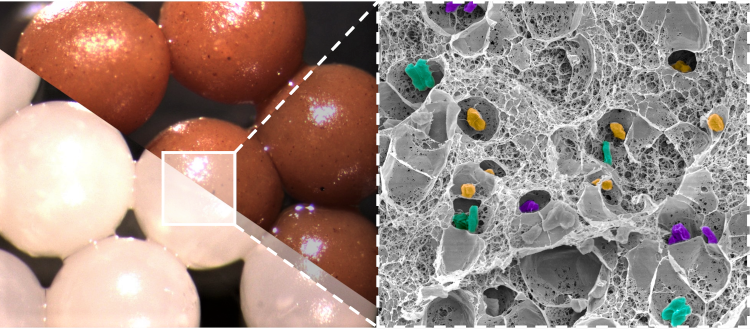A UNIGE team, in collaboration with the CHUV, has developed a new method of encapsulating fecal bacteria to treat a serious intestinal infection.

Alginate microparticles containing isolated bacterial strains (white particles) and a fecal transplant (brown particles), with a zoom on the structure of the microparticles by scanning electron microscopy. © CC BY-NC-ND 4.0 - Adèle Rakotonirina et Nathalie Boulens
Clostridioides difficile infection causes severe diarrhea and results in the death of nearly 20,000 patients in Europe each year. It is one of the most common hospital-acquired infections. When it relapses, the disease must be treated by fecal microbiota transplantation. This treatment, which is administered via a nasogastric or colorectal tube, is very demanding. Researchers at the University of Geneva (UNIGE), in collaboration with the Lausanne University Hospital (CHUV), have developed small beads to be taken orally, which could radically improve its administration. This work can be found in the International Journal of Pharmaceutics.
Naturally found in 15% of the population, Clostridioides difficile is a bacteria that can become pathogenic when the protective ''barriers'' of our intestinal flora are weakened. This is particularly the case after prolonged and repeated use of antibiotics. Clostridioides difficile then causes severe diarrhea and can lead to a critical inflammation of the colon, known as pseudomembranous colitis. With more than 124,000 cases per year in Europe, it is one of the most common hospital-acquired infections and is fatal in about 15% of cases.
Treated with antibiotics, the infection relapses in a third of patients. Transplantation of intestinal microbiota is then recommended. The treatment consists in taking intestinal flora from the feces of a healthy donor and transferring it to the digestive tract of the affected person. This effective treatment, which allows the intestinal microbiota to be reconstituted, is however very uncomfortable: it is administered through a nasogastric or colorectal tube, or by enema. Oral capsules are available, but because of their size (8.2 mm wide and 23.3 mm long) and their dosage (30 to 40 capsules over 2 days), their use is also very demanding.
Revolutionary beads
A team from the University of Geneva (UNIGE), in close collaboration with the Service of infectious diseases and the Service of pharmacy from the Lausanne University Hospital (CHUV), has developed a new technology that overcomes most of these obstacles. ''Our technique allows the micro-organisms present in the donor's stool to be encapsulated alive in small beads of about 2 millimeters, which can be taken orally,'' explains Adèle Rakotonirina, a PhD student in the School of Pharmaceutical Sciences at the UNIGE Faculty of Science and the Institute of Pharmaceutical Sciences of Western Switzerland (ISPSO), first author of the study.
The advantage of these beads is that they contain the same amount of live bacteria as the currently prescribed capsules, but in a 10-times smaller volume. To design them, the researchers mixed feces with alginate, i.e. sugars or biopolymers from a brown algae from the Phaeophyceae family. This ''mix'' of sugars and feces was then immersed, dropwise, in water containing calcium chloride. This operation has the effect of gelling the drops. The water in the drops was then extracted by freeze-drying to form small, solid beads that could carry the desired bacteria to the intestines.
Easy to administer
''When administered, these brownish beads can be easily dispersed in a liquid or food that is pleasant to eat. They also have no taste. They could therefore greatly facilitate the administration of the treatment, particularly for children,'' says Eric Allémann, full professor in the School of Pharmaceutical Sciences at the UNIGE Faculty of Science and the Institute of Pharmaceutical Sciences of Western Switzerland (ISPSO), last author of the study.
This technology, which will need to be tested in clinical trials, offers promising new prospects to fight Clostridioides difficile infection. The next step for the research team will be to coat the fecal microbiota beads to other polymers, to define the optimal mixture for delivering the bacteria to the intestines.






